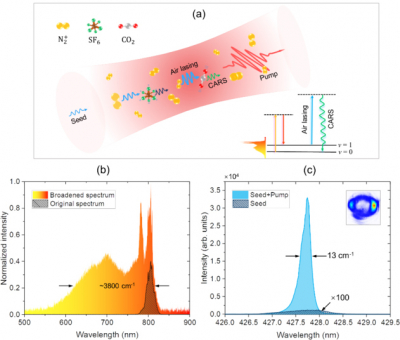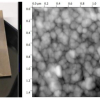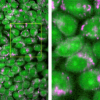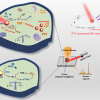
Innovative advances in ultrafast laser technologies provide new strategies for remote sensing of atmospheric pollutants and hazardous biochemical agents. The high-energy femtosecond laser can propagate a long distance without diffraction via femtosecond laser filamentation. Besides, abundant secondary radiations, e.g. supercontinuum white light, air lasing and fluorescence, provide natural probe sources for atmospheric detection at a remote location. Particularly, the discovery and intensive investigation of air lasing induced by intense femtosecond laser pulses open an exciting perspective for atmospheric remote sensing due to its ability to generate cavity-free light amplification in the open air. Although significant efforts have been paid to air-lasing-based remote sensing, the realistic application still remains challenging due to the limit of the detection sensitivity and signal stability.
Recently, the research team from the Shanghai Institute of Optics and Fine Mechanics (SIOM) of the Chinese Academy of Sciences proposed an air-lasing-assisted coherent Raman spectroscopy, realising the quantitative measurement and simultaneous detection of two greenhouse gases, as well as identification of CO2 isotopes. The detection sensitivity can reach 0.03 % and the minimum signal fluctuation is about 2 %.
In the new Raman spectroscopy technique, a femtosecond laser excites the optical gain of molecular nitrogen ions and achieves a seed amplification of more than 1000 times, resulting in 428 nm air lasing with a linewidth of 13 cm–1. Meanwhile, the spectral width of the pump laser reaches 3800 cm–1 after non-linear propagation, enabling excitation of molecular coherent vibrations of most pollutants and greenhouse gases. When air lasing encounters coherently vibrating molecules, it will effectively produce coherent Raman scattering. By recording the frequency difference of Raman signal and air lasing, the molecular “identity information” can be known. Thus, such a Raman scheme combines the advantages of the femtosecond laser and air lasing, it thus can meet the needs of multi-component measurement and chemical specificity.
Some specific designs used in this work, especially the optimisation of pump-seed delay and the choice of perpendicular polarisation, ensure a high detection sensitivity and signal stability. It was shown that the minimum detectable concentrations of CO2 and SF6 can reach 0.1 % and 0.03 %, respectively. The minimum signal fluctuation reached the level of 2 %. The research team also demonstrated that the technique can be applied for simultaneous measurement of CO2 and SF6. More importantly, the measured Raman spectrum can well distinguish 12CO2 and 13CO2.
The simultaneous measurement of various pollutants, greenhouse gases as well as the detection of CO2 isotopes are of great significance for tracing the sources of air pollution and studying the carbon cycling. This is a significant advantage of the proposed technique as compared to traditional remote sensing methods. However, for realistic application of trace gas remote detection, it is necessary to improve the detection sensitivity to the ppm or even ppb level, as well as extend the detection distance from the laboratory scale to the kilometre scale. It is expected that such a goal can be realised in the near future with the development of high-repetition, high-energy femtosecond laser technologies.














